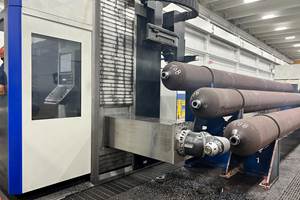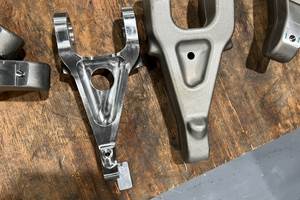Are Two Ballscrews Better Than One?
A dual ballscrew arrangement on the Z axis leaves the middle of the base open for chip evacuation, solving the problem on table feed Z-axis, horizontal machining centers.
Share






Efficient chip evacuation from horizontal machining centers is a headache for most shops. In general, efforts to automate chip removal often involve augers and flush systems designed to move chips along the outside edges of the work zone and eventually out of the area into a chip conveyor for disposal.
Toyoda Machinery USA (Arlington Heights, Illinois) has come up with what it feels is a good solution to the chip evacuation problem on table feed Z-axis, horizontal machining centers.
Most HMCs of this type use a configuration composed of a set of ways running along the side of the Z axis base structure with a ballscrew centered between them. In this design, use of the middle of the base structure for chip evacuation is precluded because the ballscrew passes through it. Therefore chips must be pushed to either side of the base for evacuation. The way covers and ballscrew covers are pitched, like a roof, to help direct the chips to the sides of the base. From there they are moved with augers or washed to a chip conveyor.
What Toyoda has done is create a center through-hole base so chips fall directly into a large capacity chip conveyor that exits the rear of the machine. The chip conveyor slides under the machine base occupying the space between the ways.
So where’s the ballscrew? Actually there are two ballscrews on this design. In order to balance the movement of the Z-axis carrier, a ballscrew is located on the right and left sides of the carrier parallel to the ways. This leaves the middle of the base open for chip evacuation.
The enabling technology for this design is a feature on the Fanuc 16i CNC called tandem control. This allows the dual axis ballscrews to perform in synchronized fashion so one or the other can’t try to skew the work table carrier.
In operation, one of the two identical AC servomotors driving the ballscrews functions as the “master,” and the other is the “slave.” The master motor controls the axis movements, while the slave motor follows.
Parallel performance is monitored and adjusted by the CNC, which reads the electrical current of the slave motor. If the current of the slave motor goes up, a signal from the control is sent so the slave self-adjusts to compensate. Synchronization is maintained.
At start-up, the Z axis is automatically “homed” using the master motor’s absolute position encoder, and the slave motor is synchronized off this position. Generally, no further mechanical alignment or adjustment is necessary between the two motors. However, should the machine need to be reset, homing the master axis drive will automatically re-synchronize the motors.
Toyoda has also applied dual ballscrews, in combination with the Fanuc 16i tandem control feature on the Y axis of its FA 800 horizontal machining center. In this case, the dual ballscrews eliminate the need to counterbalance the spindle carrier. The load of the carrier is shared between the two ballscrews, which, the company says, increase responsiveness of the axis for high-speed acceleration and rapid traverse rates.
If one ballscrew is good, two are better? That seems to be the case on these machining centers. MMS
Related Content
Large-Format Machining Simplifies Tube Manufacturing
Downtime is the enemy of efficient manufacturing — a problem FIBA Technologies has addressed through purchasing a Soraluce FLP 14000.
Read MoreHorizontal High-Speed Machining Saves Hundreds of Work Hours
High-speed machining is the latest change at Blair-HSM South, helping this once old-fashioned shop improve productivity and morale while enabling new work.
Read MoreOkuma HMC Provides Enhanced Cybersecurity, Versatility
Okuma America Corp. introduces the MA-4000H CNC horizontal machining center, designed with embedded cybersecurity features and “sludgeless tank” chip and coolant management technology.
Read MoreHurco Machine-Tending Solutions Support Range of Machining Centers
IMTS 2024: Hurco is demonstrating the capabilities of machine-tending automation through ProCobots-Hurco integration. The company is also showcasing a range of CNC machines.
Read MoreRead Next
Machine Shop MBA
Making Chips and 91ÊÓƵÍøÕ¾ÎÛ are teaming up for a new podcast series called Machine Shop MBA—designed to help manufacturers measure their success against the industry’s best. Through the lens of the Top Shops benchmarking program, the series explores the KPIs that set high-performing shops apart, from machine utilization and first-pass yield to employee engagement and revenue per employee.
Read MoreAMRs Are Moving Into Manufacturing: 4 Considerations for Implementation
AMRs can provide a flexible, easy-to-use automation platform so long as manufacturers choose a suitable task and prepare their facilities.
Read MoreLast Chance! 2025 Top Shops Benchmarking Survey Still Open Through April 30
Don’t miss out! 91ÊÓƵÍøÕ¾ÎÛ's Top Shops Benchmarking Survey is still open — but not for long. This is your last chance to a receive free, customized benchmarking report that includes actionable feedback across several shopfloor and business metrics.
Read More





















